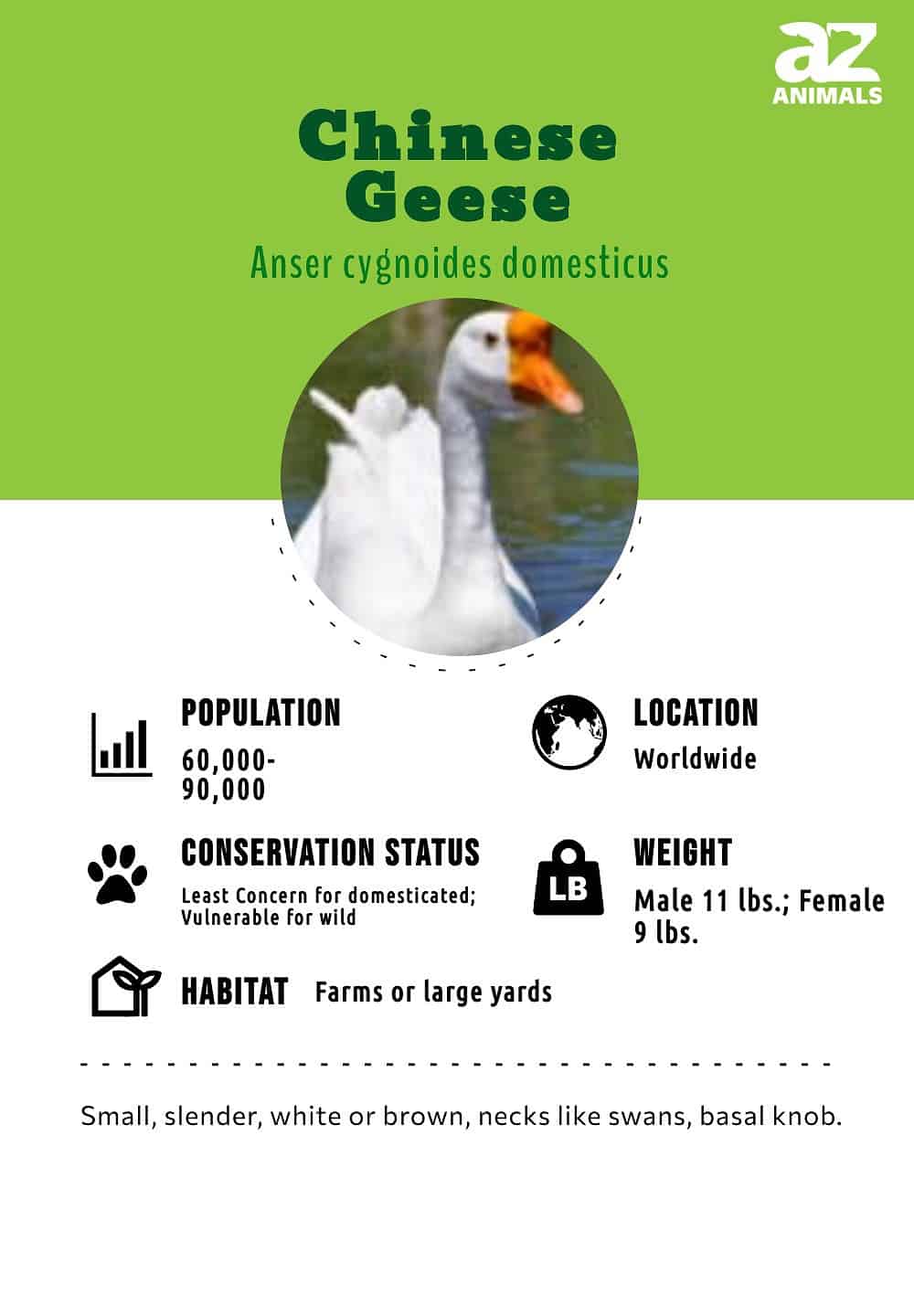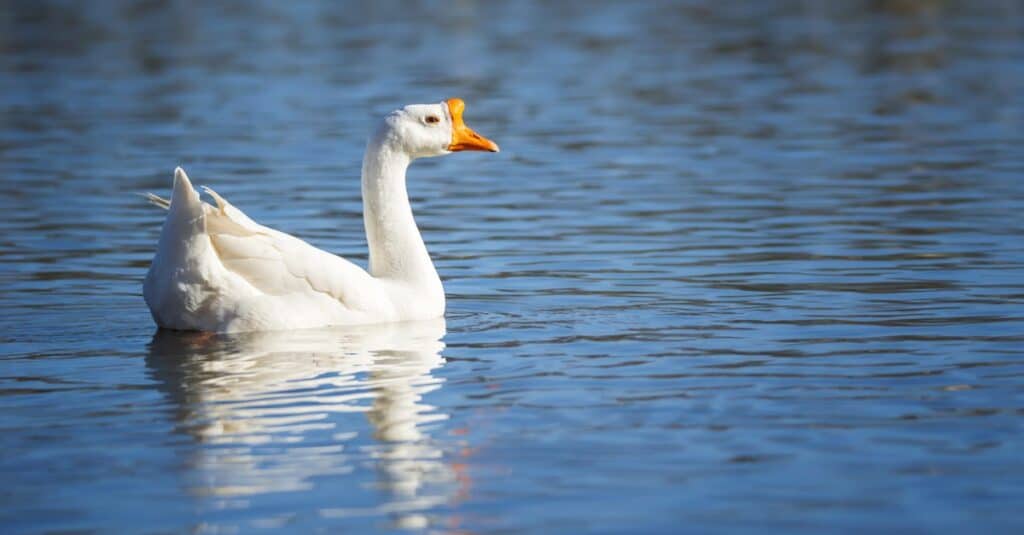Chinese Geese
Anser cygnoides domesticus
They are excellent “guard geese”
Advertisement
Chinese Geese Scientific Classification
- Kingdom
- Animalia
- Phylum
- Chordata
- Class
- Aves
- Order
- Anseriformes
- Family
- Anatidae
- Genus
- Anser
- Scientific Name
- Anser cygnoides domesticus
Read our Complete Guide to Classification of Animals.
Chinese Geese Conservation Status
Chinese Geese Facts
- Prey
- none
- Name Of Young
- gosling
- Group Behavior
- Family units
- Fun Fact
- They are excellent “guard geese”
- Estimated Population Size
- 60-90 thousand
- Biggest Threat
- predators
- Most Distinctive Feature
- Long, arched neck and raised knob
- Other Name(s)
- Swan goose
- Gestation Period
- 28-35 days
- Litter Size
- 10-15
- Habitat
- farms
- Predators
- Snakes, rats, raccoons, coyotes, and foxes
- Diet
- Herbivore
- Type
- waterfowl
- Common Name
- Chinese goose
- Location
- Kazakhstan, Mongolia, Russia, Japan, South Korea, North Korea, China, Turkmenistan, Laos, Uzbekistan, Taiwan, and Thailand
- Group
- gaggle or flock
Chinese Geese Physical Characteristics
- Color
- Brown
- White
- Skin Type
- Feathers
- Lifespan
- 15-20 years
- Height
- 2-3 feet
- Length
- 1-2 feet
- Age of Sexual Maturity
- 2 years
- Age of Weaning
- 12 weeks
View all of the Chinese Geese images!
A popular and well-known domestic goose, the Chinese goose is sometimes called the swan goose.

Many people consider the Chinese goose the most beautiful member of the goose family. Its elegant looks and long neck have given it the nickname of “swan goose.” It is a popular domestic goose known for its loud, frequent vocalizations and high egg production.
5 Incredible Fun Facts About Chinese Geese!
- A prolific layer, the Chinese goose can produce up to 60 to 100 eggs in a breeding season.
- It is related to the wild swan goose that is native to Asia.
- George Washington received a pair of Chinese geese as a gift in 1788.
- Chinese geese make excellent weeders for many gardens.
- They are guard geese who will honk loudly at any approaching danger.
Scientific Name
The Chinese goose is a Knob Goose (for its basal knob), of which there are about 20 different breeds. It is believed to have originated in China (thus its common name), and they are descended from the wild swan geese that are native to Asia. . There are two types: wild Chinese geese and domestic ones.
The scientific name for the Chinese goose is Anser cygnoid; specifically, the domesticated Chinese goose is Anser cygnoides domesticus.
Appearance

©iStock.com/leekris
Chinese geese are classified as “lightweight” domestic geese. They are small and slender. Chinese geese come in gray/brown or white coloring. White Chinese geese have white feathers, orange bills, orange legs, and striking blue eyes. Brown Chinese geese have black bills, orange feet, and brown eyes. They have long, creamy necks and pale gray breast feathers. Their necks are arched and meet their bodies at a 45-degree angle. This accounts for their uniquely elegant look.
Basal Knob
Each goose has a prominent knob at the top of its beak. This is the basal knob, and it is larger in males than females. Males typically stand up straight with their heads held high or at an upward tilt. Females are more likely to hold their heads level or at a slight downward tilt.
Uses
Because it is a lightweight goose, it’s not primarily used for meat. The average male weighs about 11 pounds, and the average female weighs about 9 pounds.
There are two strains of domesticated Chinese goose. The strain that primarily lives in the U.K. is a stocky goose that is used for egg production and as an ornamental bird. In the United States, the most common strain is a slender bird that most people use as pets or ornamental birds.

The domesticated Chinese goose can be a pet and an excellent guard with its loud honk.
©iStock.com/leekris
Behavior
These geese are notorious for their loud, varied vocalizations. If you like birds that make their presence known, you will enjoy these birds. They’re not suitable for urban farms because their honking will irritate the neighbors.
Chinese geese are intelligent and curious, but they are naturally suspicious of people. Those who are raised without human contact will become aggressive when approached.
Chinese Geese as Pets
Chinese geese that are raised with regular human interaction can become very attached to humans. If you talk to them when they are goslings, they will almost always respond with honking and chattering. If you frequently touch them, talk to them, and give them treats, these geese grow up very tame. As pets, they are affectionate and friendly. They are also excellent watch pets who will honk and squawk at any sign of danger.
Habitat
Chinese geese live on farms. They can adapt to almost any climate, and they live all over the world. Chinese geese need water sources deep enough to fit the entire bill. Like all geese, they appreciate small bodies of water where they can splash, groom themselves, and drink water.
Diet
Chinese geese primarily feed on grasses. If they have a large, grassy area where they can graze with other animals, this can be their single source of food. The grass should be four inches high at most. Allowing other animals to share the grass will help keep it low.

These brown Chinese geese, like their white counterparts, like to forage for weeds and other plants.
©Iva Vagnerova/Shutterstock.com
In warm weather, free-ranging geese won’t need much supplementation to their diet. In the winter, many people supplement their geese’s diets with dry wheat and feed pellets. These are the most nutritious choices for geese. If you feed a dry supplement, accompany it with a large bowl or bucket of water.
What Not To Feed Them
Chinese geese and other waterfowl should never eat powdered foods or dry mash. This can lead to a condition called “dropped tongue,” which is a debilitating fungal disease.
Give Them Grit
Many birds need to eat grit to maintain healthy digestion. While some geese get this by eating dirt and small stones, it’s better to supply mixed grit made from oyster shells and coarse sand.
Weeds
Chinese geese love to forage for weeds and small plants. In fact, some people use them as weeder geese in berry patches, grape crops, and other places where they can forage for weeds without disturbing the crops.
Predators and Threats
Snakes are one of the biggest threats to geese. Snakes and rats will try to eat the eggs and the baby goslings. Other predators include foxes and raccoons.
Here are some ways you can protect your geese, eggs, and goslings from predators:
- Elevate your coop. Raising a chicken or goose coop above the ground helps deter snakes.
- Control rodents. Mice, rats and squirrels often visit goose coops to feed on the spilled grains. They attract snakes, so do your best to keep them out. Some people keep barn cats in their coops for this reason.
- Block all holes. Snakes only need a small hole to get inside a coop.
- Gather eggs regularly. Don’t leave any temping treats out for snakes or other predators.
- Keep it clean. Keep the grass around your coop carefully trimmed, and clean up food spills immediately.
Reproduction and Life Cycle
The mating season usually lasts from February through May. A male goose is called a gander. After mating with the gander, the mother goose will lay a clutch of 10 to 15 eggs. Hatching takes anywhere from 28 to 35 days.
Brooding
Many geese will sit or “brood” on the eggs. When the mother wants to brood, she will show this by creating a nest in a quiet spot. During this time, she should be left alone and protected from predators. Many ganders will also stand guard on their mates while they are brooding. She must come off the nest every day. Geese that sit on the eggs without moving can kill themselves or the eggs. You may need to lift her off the eggs gently if she isn’t doing this herself.
Many young, inexperienced geese don’t know how to brood. If you have a goose that doesn’t want to brood, you can help by keeping the eggs warm and turning them over by hand every day. You may need to put them in an incubator to help them hatch.
Baby Goslings Emerge
Once the eggs hatch, the goslings will emerge. It can take two or three days for the eggs to finish cracking and for babies to emerge.
All baby goslings have yellow fuzz and orange beaks, which makes them look like baby ducklings. Goslings will double in size in the first week. Their fluffy yellow down will turn white, brown, and gray.
They have another growth spurt in week five. Their chirp will start to sound more like a honk. At twelve weeks after birth, they are ready to join their parents in the pasture.

©Leena Robinson/Shutterstock.com
Family Life
When goslings are eight weeks old, you can figure their sex by looking at their basal knobs. Males have larger basal knobs than females.
Most Chinese goose families will stay together in the pasture. It is charming to see them walking around the fields together. Chinese geese mate for life.
Population
Chinese geese are one of the most popular breeds of domesticated birds in the world. There are 60,000-90,000.
Conservation Status
Chinese domesticated geese are of Least Concern, but the wild Chinese geese are listed as Vulnerable.
View all 233 animals that start with CChinese Geese FAQs (Frequently Asked Questions)
Are Chinese geese aggressive?
Like all geese, they can be aggressive if they’re provoked. Some farmers have reported that they pick on smaller birds and ducklings. They tend to do this when they’re bored or frustrated. You can reduce their aggressiveness by raising them as pets and giving them plenty of free-range for grazing.
Are Chinese geese good pets?
They make excellent pets if you get them used to human contact from an early age. Chinese geese form strong attachments to humans, other animals and each other. They are also fiercely protective of their chosen families.
Can Chinese geese fly?
They can, but their flying ability is poor. They will never soar into the sky like a Canada goose.
How long do Chinese geese live?
They live 15 to 20 years.
What do Chinese geese eat?
They eat grass, weeds and wheat. Chinese geese make excellent weeders because they eat weeds without disturbing the surrounding crops.
Why do Chinese geese have bumps on their head?
The basal knob is a large, round protuberance on a bird’s bill. It is usually at the base of the bill and can vary in size. Most ducks, swans, geese, and other waterfowl have one.
Scientists aren’t sure why birds have them, but they believe the knobs might be a way of telling males apart from females during the breeding season. They may also be indicators of the bird’s health.
What do Chinese Geese look like?
They are slender birds with long necks that make them look like swans. Their feathers can be white or brown. They are lightweight and slender compared to other domestic geese. These geese have a noticeably large, dark basal knob that is larger in ganders.
How tall do Chinese geese get?
They can grow up to 2 or 3 feet tall. It is rare for them to be over 3 feet tall.
Thank you for reading! Have some feedback for us? Contact the AZ Animals editorial team.
Sources
- poutlrykeeper.com / Accessed September 13, 2021
- Community Chickens / Accessed September 13, 2021
- Murray McMurray Hatchery / Accessed September 13, 2021















